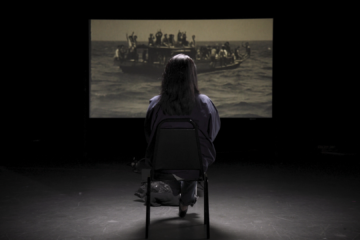The 20th Anniversary of Viet Film Fest continues showcasing stories relating to the Vietnamese diaspora with the selection of the short film, Flowing Home. The story details the intertwining fates of two Vietnamese sisters who sustain their relationship through written correspondence. In a conversation with the director, Sandra Desmazières, the interview delves into the intersection of her creative process, personal family history, and her background as an illustrator, which converge to shape the themes of the film.
In addition to being a filmmaker, you also work as an illustrator for children’s books and as a comic book colorist. What are the particulars behind making an animated film like this, and what did you want to emphasize the most when creating your work?
When I write a script, a large part comes by drawing: I imagine the scenes [and the visual atmosphere], but also by imagining the sound atmosphere, the music. It’s very stimulating. I love to tell myself that my drawings will move, come to life in a way. The animation and the editing gets to the essentials of the story and kept the moments with the necessary information for audiences to understand the film and also have a place for their memories and dreams. I only show some moments of the war of Vietnam and its repercussions on Thao and Sao Maï. The sisters haven’t seen each other for almost 20 years. The film is very ellipsed and, with the letters, I can evoke sequences that we don’t see.
Flowing Home is a story about two sisters who are separated by the Vietnam War and how they keep in touch by writing letters to each other. What inspired you to tell this story?
My parents met in Vietnam during the war in the early 1970s. My father is French and my mother is Vietnamese. Apart from some anecdotes that my parents told me and war films, I only had this vision of Vietnam and I wasn’t really interested in it since we weren’t talking about the past. When I was a child, there was a drawer full of letters – my mother’s correspondence with Vietnam, her family. I didn’t understand what was written there so I closed the drawer. Later I wanted to know more about my family, about Vietnam. I understood that many families had been separated, and I was beginning to become aware of the violence of life. The story of my friends also inspired me. Little by little, I wanted to make a film on this subject.
The lighting/shading seems to play an important role in setting the tone for the scene. What are some of the effects that you wanted to produce when using lighting?
This is the image I had of Vietnam after my travels. Night images with the lighting of small lamps, neon lights, and green walls. The green is a very present color in Vietnam: the nature, the vegetation, or the houses. It is something obvious. Also the sun rises around 6 a.m. and sets around 6 p.m., so a lot of things happen in the evening with its dark colors. It is also the moment to leave, to escape, to dream, to remember. To escape in the intimacy. In any case, it is the atmosphere that I have in mind.
What would be the significance of the river (dòng song) or the image of flowing in the title? In addition to its association to the experience of Vietnamese boat people and refugees, how could “water/river” or “flowing” be interpreted in the film?
There are several meanings. Memory is like the meanders of a river, the idea of memories, the memory that comes and goes, that is lost, by hundreds of paths and finds its way. But [it also represents] the sisters, the families who separate and find themselves like the arms of a river… Finally, memory, memories, families are like a river that can get lost in the meanders or, on the contrary, come together. The sisters’ past is like a flowing river – the idea of flowing water, of finding its roots, its house.
How did you want to depict violence or death in your film? The grenade, the shooting sounds, and also the spirits or ghosts that stay with Sao Maï. How did you want to portray such violence or death, and what did you want to emphasize the most when doing so?
When my parents told me about the time of the war, my mother always said that she heard the bombs explode in the distance and the sirens of the ambulances that crossed Saigon. We weren’t talking about death, but I felt the weight of many emotions. I wanted to show violence and death as I perceived it in my imagination when I was younger – something omnipresent that we did not necessarily see but that was there. [I wanted to] suggest with sound, for example, rather than showing everything to understand the violent context of an exploding grenade or the disappearance of a loved one.
(Interviewed by Jiyon Byun)
####
Flowing Home will be shown twice in-person at the Frida Cinema in Santa Ana, California as part of Viet Film Fest 2023. It will be screened at 4 PM on Friday, October 6 as part of the “Belonging/Unbelonging” short film set, as well as at 12:30 PM on Saturday, October 7 (when it will precede Refuge After War). Flowing Home will not be available for viewers outside the United States.
ABOUT Sandra Desmazières
Born in 1978, Sandra Desmazières studied at the Duperré School of Applied Arts in Paris. She then entered the École nationale supérieure des arts décoratifs de Paris, where she discovered animation. Her final-year film, Sans queue ni tête, won the 2003 Cartoon d’or. She went on to make two short films produced by Les Films de l’Arlequin, Le thé de l’oubli (2008) and Bao (2011). In addition to being a filmmaker, Sandra is an illustrator of children’s books. Her most recent projects were Méandre, written by Muriel Bloch (2019, Éditions Le Robert), and Mai Anh, written by Didier Dufresne (2020, Éditions Mango). She also works as a comic book colourist for projects such as À mains nues, by Leïla Slimani and Clément Oubrerie (2020, Éditions Les Arènes). Sandra just finished shooting her most recent short film, Như một dòng sông (Flowing Home).
VIET FILM FEST 2023
September 30th to October 15th, 2023
Program Schedule and Tickets:
https://vff2023.eventive.org/welcome
Follow @vietfilmfest on Facebook, Instagram, and YouTube



0 Comments